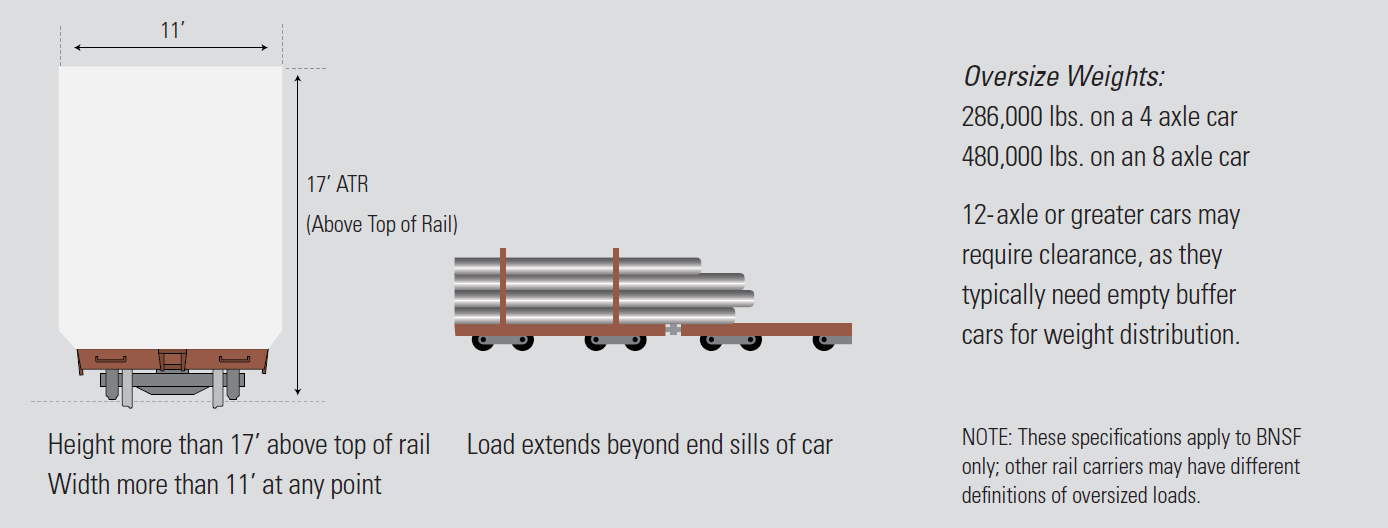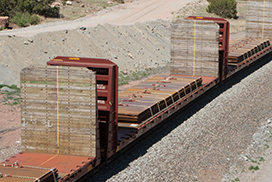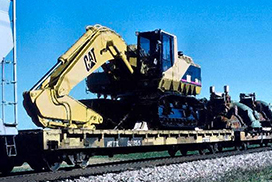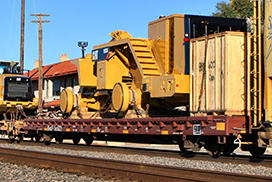Do you have a very large product or piece of equipment you need to move? Consult with the professionals at BNSF. We have decades of experience moving a wide range of raw materials and finished goods.
Other Oversized
Determine if your shipment is an oversized load according to BNSF by using the following criteria:
286,000 lbs. on a 4 axle car
480,000 lbs. on a 8 axle car
12-axle or greater cars may require clearance, as they typically need empty buffer cars for weight distribution. Height more than 17' above top rail
Width more than 11' at any point Load extends beyond end sill of car
Note: The above specifications apply to BNSF only, other rail carriers may have different definitions of oversized loads.
To obtain a rate for machinery and oversized, please use BNSF's online pricing tools .
Pricing Tools and Resources
- Use our Get a Freight Rate tool to obtain a price for shipping machinery and oversized.
- Machinery and oversized are moved under various price authorities .
- Standard Carload Policies are under BNSF 6100-Series
Before scheduling an oversized shipment, please read the following guidelines:
1. MEASURE IT
(At least 8 weeks before shipment)
Determine if your shipment is an oversized load according to BNSF by using the following criteria: 
2. PRICE IT
(At least 8 weeks before shipment)
Get a quick pricing quote by logging into the BNSF Customer Portal on BNSF.com and using our pricing tool – Get A Freight Rate.
Note: Rates are subject to change based on the clearance route. Please confirm validity of the quoted rate once the route has been approved and be sure to read the shipping conditions to obtain the appropriate price. If you do not have access to the BNSF Customer Portal, click the customer registration link at BNSF.com.
3. CLEAR IT
(At least 8 weeks before shipment)
For shipments that are oversized, your clearance request lets us officially initiate the process to confirm that our infrastructure can handle your load. To submit your clearance request, log into BNSF.com, go to All Web Tools, select Hi-wide Dimensional Clearance Request Form. We evaluate primary and secondary routes and let you know your best shipping option. You’ll also receive a proposal number that you’ll need through the rest of the process. Each request includes a $2,000 fee, which is refundable on all proposals that become actual loads on BNSF within 18 months.
Note: Clearance requests must be submitted to the originating rail carrier. To submit your clearance request, you will need to establish your loading and unloading sites, then log in to BNSF.com.
4. SECURE IT
(At least 4 weeks before shipment)
For oversized loads BNSF needs to review your securement plan in order to ensure that your cargo is safe across the BNSF network. To submit your securement plan for review, email OPEN TOP LOADS.
5. REQUEST CARS
(2-4 weeks before shipment)
The next step is to request the railcars you’ll need. Log into BNSF.com and go to All Web Tools. To request a heavy-duty railcar, select Dimensional Equipment Approval Required Form. You’ll need your proposal number and the railcar series or equipment car initial and number. To request a standard machinery flatcar, select the Railcar Equipment Request Form.
Note: Availability of railcars is subject to current supply conditions, so please allow 2-4 weeks for delivery.
6. LOAD IT
(2 days before shipment)
Next, you’ll need to load and secure your railcar according to the approved securement plan you submitted and the Association of American Railroads (AAR) Open Top Loading Rules. Contained within the AAR rules are specific diagrams for loading configurations, as
well as the general rules that you must follow. To obtain a copy of the AAR Open Top Loading Rules Manual, call 800-544-RAIL or email PUBS.
Note: It is the shipper’s responsibility to correctly load and secure the load.
7. GET INSPECTED
(2 days before shipment)
All loaded oversized shipments must be approved before the shipment can receive final clearance and be moved. To start this process, email HIGH WIDE (at least 5 business days in advance of your planned ship date) requesting an inspection and include the date of inspection needed, location, railcar(s), and an on-site contact. For shipments with eight or more axles, also include INSPECTIONS. Upon receipt of request and once personnel resources are scheduled, a team member will respond back confirming or providing an alternate inspection date.
Note: You should contact BNSF one week before loading and securing your shipment to schedule your inspection and ensure AAR and BNSF compliance.
8. SUBMIT INSTRUCTIONS
(2 days before shipment)
Proper shipping instructions are essential for BNSF to provide the correct transportation services and invoice at the appropriate rate. To submit your shipping instructions, log into BNSF.com, go to All Web Tools, and select Shipping Instructions. You’ll need the appropriate rate authority. For oversized loads, you’ll also need your proposal number, and you’ll need to select a special handling condition of “Extreme Dimension.”
Note: You can also submit shipping instructions via EDI, through voice activation by calling 1-888-428-2673, or through the rail industry website www.steelroads.com.
9. SHIP IT!
That's about the size of it.
Bulkhead Flatcar
Some of the commodities transported include structural steel, pipe, steel plate and some lumber products.

| Specifications Table | Diagram (56ft) | Diagram (60ft) | Diagram (62ft) | Diagram (66ft) | Diagram (70ft) |
|---|---|---|---|---|---|
| Inside Length | 56.8 ft | 60.8 ft | 62 ft | 66 ft | 70 ft |
| Inside Width | 9.3 ft to 10.5 ft | 8.2 ft to 10.6 ft | 9.3 ft to 10.6 ft | 10 ft | 8.8 ft |
| Lading Capacity | 143,500 to 196,000 lbs | 178,500 to 186,000 lbs | 163,400 to 205,100 lbs | 183,500 to 188,600 lbs | 173,800 to 181,200 lbs |
** All materials are provided for informational purposes only; BNSF makes no warranty regarding accuracy and shall not be liable for any errors and/or omissions. Materials are subject to change at any time without notice or publication. Please consult with the Equipment Department for the most up-to-date data.
60 ft Chain Tie-Down Flatcar

| Specifications Table | Diagram (HTTX) | Diagram (OTTX) | Diagram (TTHX) |
|---|---|---|---|
| Deck Length | 60 ft | 60 ft | 60 ft |
| Deck Height - ATR | 3.9 ft | 3.9 ft | 3.9 ft |
| Deck Width | 10.6 ft | 10.6 ft | 10.6 ft |
| Deck Type | Wood | Wood | Wood - with stake pockets |
| Deck Fittings | Chains in 4 longitudinal channels, stake pockets | Chains in 4 longitudinal channels, stake pockets | Chains stored in side stake pockets (9 per side) |
| Chain Count & Size | 36 ea 1/2 inch heavy duty chains, 12 ft in length | 48 ea 3/8 inch alloy chains, 8 ft in length | 18 ea 1/2 inch heavy duty chains, 8 ft in length |
| Lading Capacity | 152,600 lbs (avg) | 153,800 lbs (avg) | 155,400 lbs (avg) |
| Plate | B | B | B |
** All materials are provided for informational purposes only; BNSF makes no warranty regarding accuracy and shall not be liable for any errors and/or omissions. Materials are subject to change at any time without notice or publication. Please consult with the Equipment Department for the most up-to-date data.
68 ft Chain Tie-Down Flatcar

| Specifications Table | Diagram (ATSF/BNSF) |
|---|---|
| Deck Length | 68 ft |
| Deck Height - ATR | 5.3 ft |
| Deck Width | 9.6 ft |
| Deck Type | Wood - with stake pockets |
| Deck Fittings | Chains in 4 longitudinal channels, stake pockets |
| Chain Count & Size | 40 ea 1/2 inch heavy duty chains, 9 ft in length |
| Lading Capacity | 231,500 lbs (avg) |
| Plate | B |
** All materials are provided for informational purposes only; BNSF makes no warranty regarding accuracy and shall not be liable for any errors and/or omissions. Materials are subject to change at any time without notice or publication. Please consult with the Equipment Department for the most up-to-date data.
89 ft Chain Tie-Down Flatcar

| Specifications Table | Diagram (ITTX) | Diagram (ITTX) | Diagram (TTDX) |
|---|---|---|---|
| Deck Length | 89 ft | 89 ft | 89 ft |
| Deck Height - ATR | 3.10 ft (Max. 7.8 ft including top-mounted hand brake) | 3.9 ft | 3.9 ft |
| Deck Width | 8.6 ft to 9 ft | 8.6 ft to 9 ft | 8.6 ft to 9 ft |
| Deck Type | Steel | Wood | Steel |
| Deck Fittings | Chains in 2 longitudinal channels | Chains in 4 longitudinal channels | Chains in 2 longitudinal channels |
| Chain Count and Size | 36 ea 3/8 inch alloy chains, 10 ft in length | 36 ea 3/8 or 1/2 inch alloy chains, 10 ft in length | 16 ea 1/2 inch heavy duty chains, 9 ft in length |
| Lading Capacity | 149,500 lbs (avg) | 142,000 lbs (avg) | 148,300 lbs (avg) |
| Plate | B | B | B |
** All materials are provided for informational purposes only; BNSF makes no warranty regarding accuracy and shall not be liable for any errors and/or omissions. Materials are subject to change at any time without notice or publication. Please consult with the Equipment Department for the most up-to-date data.
Private Equipment Guidelines
The following section contains guidelines and information for the use of privately marked equipment where BNSF is the origination line-haul carrier.
- Private rail equipment must meet the Association of American Railroads' (AAR's) Circular OT-5 for Rules Governing the Assignment of Reporting Marks and Mechanical Designations. Privately marked equipment must also be registered via the OT-57 process that is administered by Railinc. For more information, please visit Railinc's Loading Authority (OT-57) web site.
- Private equipment controlling entities are required to manage the flow (pipeline) of empty equipment moving to BNSF origin line haul locations or connecting carrier serving locations to preserve network fluidity.
- BNSF may require private equipment controlling entities to move equipment off-line at their expense to preserve network fluidity.
- Private equipment is subject to charges for both equipment held for loading and unloading and equipment held for purposes other than loading or unloading.
- BNSF's Mechanical Requirements for Private Equipment listed below.
SAFETY IS BNSF'S MAIN PRIORITY
The following is not all inclusive. However, equipment must comply with all of the following key mechanical requirements:
- All interchange freight car owners must subscribe to the AAR Interchange Rules and be listed in FindUs.Rail.
- Cars must comply with and be maintained, by the owner, per the AAR Office and Field Manual Rules.
- All AAR Field Manual Rules (Sections A.1 and A.2 defects along with any component obsolete or prohibited in interchange) must be complied with and equipment must be repaired or replaced prior to placement of the cars on BNSF.
- All cars must have yellow Federal Railroad Administration (FRA) 224 compliant reflectorization with the application date registered in Umler (no grandfathered material allowed).
- Angle cocks located below the coupler as shown in AAR Field Manual Rule 5 Figure 14 are prohibited.
- Greater than 268,000 Pound Gross Rail Load Freight Cars of any car type must meet one of the following criteria:
- Cars are approved by the AAR per Specification S-286 or
- Cars are approved by the AAR per Specification S-259 and the following is met: Cars must be equipped with constant contact side bearings, preferably long travel.
- Cars must be registered with the proper Star Code.
- 286,000 Pound Gross Rail Load Freight Cars of any car type less than 44 feet 11 inches in overall length must have route specifically approved by BNSF due to bridge loading concerns. The following link can assist in route selections: Rail Network Maps.
- Flat Cars of any type and capacity must be equipped with constant contact side bearings. Long travel constant contact side bearings are preferred.
- Covered Hoppers must have outlet gates that seal completely. The sealing member must be maintained in good condition and not allow product to bypass the gaskets/seals and leak onto the ground. All gates must be of a positive lock design with security seal capability.
- Cars equipped with one or more rotary couplers must be equipped with anti-gravity locks on both ends.
- All Cars must meet AAR and FRA Safety Appliance Standards.
- Gondolas and bulkhead flat cars must be equipped with crossover platform and associated safety appliances on both ends.
- Bottom dump coal hopper cars equipped with door line air hose must have this hose in the "low" configuration as to not block the crossover platform.
- Tank cars must be equipped with a Group R "weather resistant" slack adjuster.
Foreign Marked Equipment Guidelines
Foreign marked equipment is defined as equipment having reporting marks of a non-BNSF controlled railroad or equipment that contains non-private marks. Private marks are defined as equipment initials ending with an X, with the exception of TTX owned/controlled equipment.
- Request for assignment of foreign marked equipment should be in accordance with Car Service Rule 16. Requests should be made through your BNSF representative.
- BNSF reserves the right not to use foreign marked equipment when BNSF-controlled equipment is available. If no agreement exists with customers/controlling entities to utilize foreign marked cars, BNSF may refuse to place non-BNSF marked equipment for loading and may return them to the railroad whose marks are stenciled on the cars.
- Prior to securing foreign marked equipment to be loaded at a location where BNSF is the origin line haul carrier, customers/controlling entities must discuss equipment options with their BNSF sales representative.
Loading Origin Guarantees
Shippers have the ability to guarantee equipment supply through BNSF's Loading Origins Guarantee (LOGs) program. Log in to our Customer Portal to find more information.
Heavy Duty Car
To reserve a heavy duty car, contact TTX or Kasgro prior to making arrangements for shipment of freight.
- New to Rail
- Standard Carload Policies are under BNSF 6100-A
- Weight Restriction Maps
- Extended Equipment Use and Services
- Loading & Shipment Safety
- Carload Reference Guide
- Hazardous Waste Manifest
- Pay for Proposal refund
- Open Top Loading Rules
- BNSF Team Tracks
- Serving Carrier Reciprocal Switch Inquiry Tool
- Economic Development
| Pricing/Rates | ||
|---|---|---|
| Area | Name | Contact |
| Rate Requests | Easily search available rates, collaborate with BNSF on rates, as well as track the progress on rates for new opportunities. |
|
Sales |
Tel: 623-463-4182 |
|
Clearance |
Tel: 888-428-BNSF (2673) |
|
Support |
Tel: 888-428-BNSF (2673) |
|
*You need a PIN to call and inquire about oversized shipments.
Shipping Questions
Shipment support |
Customer Support |
This is who we are.
Safety & Security
BNSF is committed to the safe operation of every mile of our 32,500-route-mile network.
LEARN MOREEnvironment
BNSF believes it is good business and good citizenship to minimize our impact on the planet.
LEARN MOREHistory
BNSF is the result of more than 390 railroad lines that merged or were acquired during our 175-year history.
LEARN MORECommunity Support
BNSF strives to maintain strong relationships with the communities where our employees live.
LEARN MORENew to Rail or BNSF?
Our consistent and cost-effective service takes products of any size to customers when and where they need them.
GET STARTED